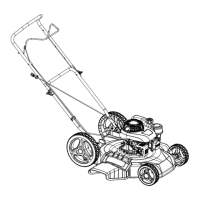Mulching the Clippings
Your mower comes mulch ready. If you have a grass
catcher please remove it before mulching.
Bagging the Clippings (Not Included)
Use the grass catcher when you want to collect grass
and leaf clippings from the lawn.
A worn grass catcher could allow small stones and
other similar debris to be thrown in the operator’s
or bystander’s direction and result in serious personal
injury or death to the operator or bystanders.
The blade is sharp. Contact with the blade can cause
serious personal injury.
Stop the engine and wait for all moving parts to stop
before leaving the operating position.
Operating Tips
General Mowing Tips
• Clear the area of sticks, stones, wire, branches, and
other debris that the blade may hit.
• Avoid striking solid objects with the blade. Never
deliberately mow over an object.
• If the mower strikes an object or starts to vibrate,
immediately stop the engine, disconnect the spark
plug and examine the mower for damage.
• Replace the blade when necessary with an AVVIX
replacement blade.
Cutting Grass
• Cut only a third of the grass blade at a time. Do not cut
bellow the 1.75 inch setting unless the grass is sparse
or it is late in the fall when grass growth begins to slow
down.
• When cutting grass over 6 inches tall, mow at the highest
cutting height setting and walk slower. Then adjust your
adjustment height lever to the desired height and mow
again. If the grass is to tall it will be more difficult to
navigate and could get stuck and cause the engine to
stall.
Wet grass or leaves can cause serious injury if you
slip and contact the blade. Mow only in dry conditions.
6
• Alternate the mowing direction. This helps disperse
the clippings over the lawn for even fertilization.
• If the finished lawn is unsatisfactory, try one or more
of the following.
• Replace the blade or have it sharpened.
• Walk at a slower pace while mowing.
• Raise the cutting height on your mower.
• Cut the grass more frequently.
• Overlap cutting swaths instead of cutting a
full swath with each pass.
• Set the cutting height on the front wheel one
notch lower than the rear wheels. For example,
set the front wheels at 2 inches and the rear at
2-1/2 inches
High Altitude Operation
Most small engines with carburetors are designed to
work efficiently from sea level to around 5,000 feet
elevation. As altitude increases, the air becomes thinner
with less available oxygen. This causes the air/fuel
mixture to become overly rich which can cause reduced
performance, spark plug fouling, difficult starting and
increased emissions.
A competent small engine shop can modify the carburetor
by installing different ‘jets’ that are designed for high
altitude operation. If your lawn mower is typically operated
at an altitude of 5,000 feet or above, you should ask your
dealer to ‘re-jet’ the carburetor and calibrate the air fuel
mixture to maximize performance at the altitude where it
is to be used. You will realize better overall performance,
while reducing excess emissions that occur when the
air/fuel mixture is too rich. This modification need only
be done once and should last for the life of the mower.
Keep in mind that any engine, even with properly
calibrated carburetor jets, will realize a decrease in
horsepower of about 3.5% for every 1,000 feet
(300 meter) increase in altitude, simply due to thinner
air. But an engine with a properly jetted carburetor will
always run cleaner and more efficiently at high altitude
than an identical unit with standard jets.
WARNING
WARNING
WARNING

